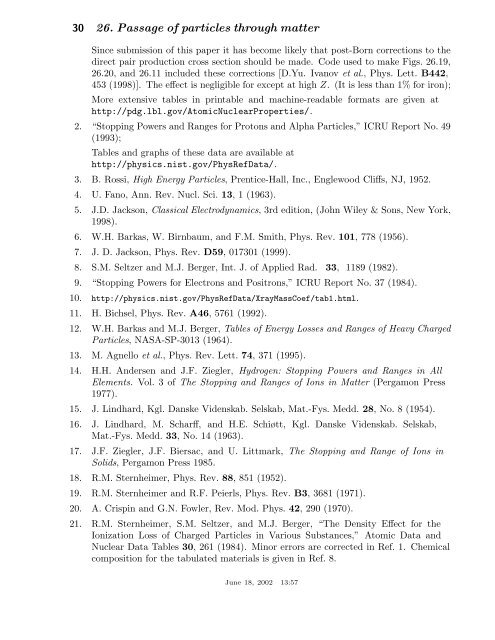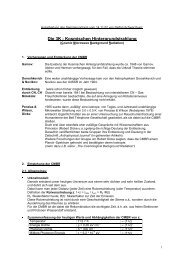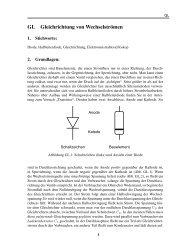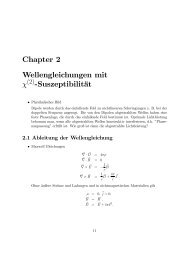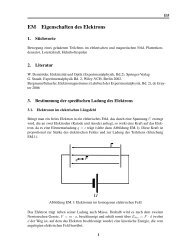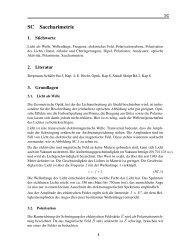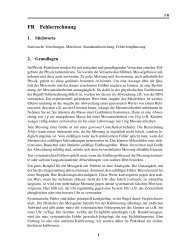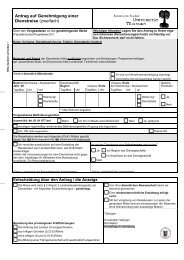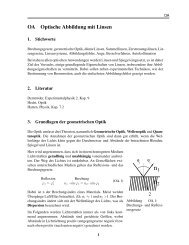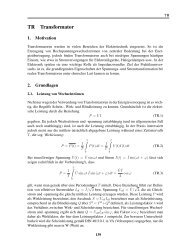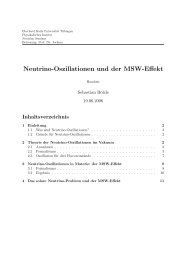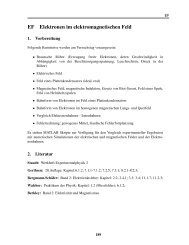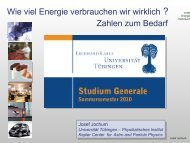26. passage of particles through matter - Particle Data Group
26. passage of particles through matter - Particle Data Group
26. passage of particles through matter - Particle Data Group
You also want an ePaper? Increase the reach of your titles
YUMPU automatically turns print PDFs into web optimized ePapers that Google loves.
30 <strong>26.</strong> Passage <strong>of</strong> <strong>particles</strong> <strong>through</strong> <strong>matter</strong><br />
Since submission <strong>of</strong> this paper it has become likely that post-Born corrections to the<br />
direct pair production cross section should be made. Code used to make Figs. <strong>26.</strong>19,<br />
<strong>26.</strong>20, and <strong>26.</strong>11 included these corrections [D.Yu. Ivanov et al., Phys. Lett. B442,<br />
453 (1998)]. The effect is negligible for except at high Z. (It is less than 1% for iron);<br />
More extensive tables in printable and machine-readable formats are given at<br />
http://pdg.lbl.gov/AtomicNuclearProperties/.<br />
2. “Stopping Powers and Ranges for Protons and Alpha <strong>Particle</strong>s,” ICRU Report No. 49<br />
(1993);<br />
Tables and graphs <strong>of</strong> these data are available at<br />
http://physics.nist.gov/PhysRef<strong>Data</strong>/.<br />
3. B. Rossi, High Energy <strong>Particle</strong>s, Prentice-Hall, Inc., Englewood Cliffs, NJ, 1952.<br />
4. U. Fano, Ann. Rev. Nucl. Sci. 13, 1 (1963).<br />
5. J.D. Jackson, Classical Electrodynamics, 3rd edition, (John Wiley & Sons, New York,<br />
1998).<br />
6. W.H. Barkas, W. Birnbaum, and F.M. Smith, Phys. Rev. 101, 778 (1956).<br />
7. J. D. Jackson, Phys. Rev. D59, 017301 (1999).<br />
8. S.M. Seltzer and M.J. Berger, Int. J. <strong>of</strong> Applied Rad. 33, 1189 (1982).<br />
9. “Stopping Powers for Electrons and Positrons,” ICRU Report No. 37 (1984).<br />
10. http://physics.nist.gov/PhysRef<strong>Data</strong>/XrayMassCoef/tab1.html.<br />
11. H. Bichsel, Phys. Rev. A46, 5761 (1992).<br />
12. W.H. Barkas and M.J. Berger, Tables <strong>of</strong> Energy Losses and Ranges <strong>of</strong> Heavy Charged<br />
<strong>Particle</strong>s, NASA-SP-3013 (1964).<br />
13. M. Agnello et al., Phys. Rev. Lett. 74, 371 (1995).<br />
14. H.H. Andersen and J.F. Ziegler, Hydrogen: Stopping Powers and Ranges in All<br />
Elements. Vol. 3 <strong>of</strong> The Stopping and Ranges <strong>of</strong> Ions in Matter (Pergamon Press<br />
1977).<br />
15. J. Lindhard, Kgl. Danske Videnskab. Selskab, Mat.-Fys. Medd. 28, No. 8 (1954).<br />
16. J. Lindhard, M. Scharff, and H.E. Schiøtt, Kgl. Danske Videnskab. Selskab,<br />
Mat.-Fys. Medd. 33, No. 14 (1963).<br />
17. J.F. Ziegler, J.F. Biersac, and U. Littmark, The Stopping and Range <strong>of</strong> Ions in<br />
Solids, Pergamon Press 1985.<br />
18. R.M. Sternheimer, Phys. Rev. 88, 851 (1952).<br />
19. R.M. Sternheimer and R.F. Peierls, Phys. Rev. B3, 3681 (1971).<br />
20. A. Crispin and G.N. Fowler, Rev. Mod. Phys. 42, 290 (1970).<br />
21. R.M. Sternheimer, S.M. Seltzer, and M.J. Berger, “The Density Effect for the<br />
Ionization Loss <strong>of</strong> Charged <strong>Particle</strong>s in Various Substances,” Atomic <strong>Data</strong> and<br />
Nuclear <strong>Data</strong> Tables 30, 261 (1984). Minor errors are corrected in Ref. 1. Chemical<br />
composition for the tabulated materials is given in Ref. 8.<br />
June 18, 2002 13:57


